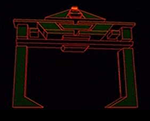
I met up with [Kenji Larsen] at HOPE X last weekend, and I’m fairly certain he was the coolest person at a conference full of really cool people. Talking to him for a little bit, you get a sense of what it would be like to speak with [Buckmister Fuller], [Tesla], or any of the other ‘underappreciated, but not by people in the know’ minds scattered about history. I’ll just let his answers to our hacker bio questions demonstrate that.
 [Kenji]’s project for The Hackaday Prize is the Reactron Overdrive. It’s not just one board he’s building here, but an entire suite of sensors, interfaces, and nodes that form a complete human to machines – note the plural ‘machines’ – interface. When you consider that no one knows what the Internet of Things actually is, and that [Kenji] is working on IoT 3.0, you get a sense that there’s really something here. Also, his project log has a Tron Recognizer in it. That has to count for something, right?
[Kenji]’s project for The Hackaday Prize is the Reactron Overdrive. It’s not just one board he’s building here, but an entire suite of sensors, interfaces, and nodes that form a complete human to machines – note the plural ‘machines’ – interface. When you consider that no one knows what the Internet of Things actually is, and that [Kenji] is working on IoT 3.0, you get a sense that there’s really something here. Also, his project log has a Tron Recognizer in it. That has to count for something, right?
Interview/Bio below.
![]()
![]()
Data analysis and prototyping for product and process development. I would characterize it as hacking, actually. There is a fair amount of metrology, experimentation and testing, visualization, simulation, and a lot of coding. There is a lot of time and workflow analysis. I analyze what can be done asynchronously, and what things must be done in critical path; what can be left open-loop, what must be done with feedback. There is usually a “critical now” period in every process that is supported by several non-linear, asynchronous worker processes. This got me thinking that really, human existence is the real “critical now” and we should use technology and just-in-time manufacturing methods, with the same non-linear optimization to augment that existence. Human experience is not just something we have by virtue of being alive – it is also something we are in charge of, can improve, optimize, and really is our most important product. That thinking led me to trying to do this with my own life’s workflow, and later led to my entry in The Hackaday Prize.
![]()
Violins and antique violin restoration. Here is a machine (and work of art) that is old enough to have a real natural evolution. Made of several different woods, animal substances, plant extracts, minerals, and insect secretions, this thing is the definition of hacking diverse stuff around you for optimum output. End result beauty. The older ones need some help to continue their beautiful existence. Restoration is not just repair – it’s harder in a lot of ways, because you must respect the flaws and exceptional excellences of what came before, remain true to the personality you found. It’s not just about bringing the machine back to some standard. I mean, that is part of it, but there is more to it. Maybe this is my passion because there are things about this that I cannot yet quantify (despite a lot of efforts!)
![]()
Cable box. So many reasons. But in reality it’s not something I would ever do. Poor defenseless components are better upcycled into awesome machines.
![]()
![]()
Well this is another tough question because I have several benches, all different. In my prototyping work, I have separate benches for electronics work, woodworking, inspection/measurement, microscopy, vacuum, high voltage, and sewing (yes, for wearables). There’s also a photography area but let’s not call that a “bench”.

manipulate anything you need. From pushing around carbon fiber cloth in resin, to holding something you are machining on the CNC, to moving something you are looking at under the microscope, or holding something tiny down when you are soldering, or pushing textiles through a sewing machine when you are working on something small, these are totally versatile. I have several colors so that if I need several in a single job, I can keep them straight, if they need to touch different chemicals or whatever. I also grade the point angle by color, so I know what I am reaching for (asynchronous process, sight and recognition) before I obtain it – keeps the workflow utilization up.
![]()
Does the Earth’s crust count? (42.) If we are talking about a semiconductor design, it is very tough, there are so many. I have to say I do really appreciate the INA128/129 instrumentation amplifier. I mean I love the ATMega328P but that’s a higher level thing, more complex, and doesn’t need me to get it more press and admiration. The INA128/129 is simple, clean, and does for ADCs what the electron microscope does for the eye. Power in, high-resolution knowledge out, I like it.
![]()
C++. I think it is the best compromise of a lot of factors. Been that way for a lot of years. I will accept a better compromise, but so far haven’t seen one. I don’t like languages that attempt to make things easy for you by doing things for you in undocumented ways under the hood. It’s usually at the cost of performance, and loss of control over the process. I like manipulating memory directly.
![]()
- Extend the time from now until I die (and stabilize bio-age at a good spot). Aubrey de Grey, hello! Help him, please – everyone help him if you can. I am trying to figure out how I can help. So I guess the top item is, the “How can I help Aubrey de Grey?” Project. (If this one works, I will get to complete more projects.) Maybe just writing this is helping by raising awareness. Here is a TED talk. Look, I am working on this project already!
- Build a practical anti-neutronic fusion reactor. People seem to be focused on Boron 11 at this time, but I have some ideas about Lithium 7 which has a good cross-section and seems just as promising. Lots of people have built fusors for regular deuterium reactions, so it’s not fantasy – but they are not over-unity yet. It seems like it may just be a matter of time before the right balance of things is achieved. I think Polywell technology is cool and I would just love to have some time to investigate it further. Fusion@home. Open source. I am sure someone will get to this before me, and that will take it off the list (or at least move it way down) because then it just becomes a formula – for me the discovery and experimentation process is the fun part – you know, the hacking.
- Engineered organs, like a seven-pump distributed heart (like RAID for blood flow). But people are doing this sort of thing now, and will likely get to it before I will. I’m cool with that, you go, people! Take the whole liver situation. We have to do better than transplants from corpses, or half-organ donations. The liver is one organ we know can regenerate parts on its own! 3D printing, extracellular matrix + stem cells, it sounds like an there is an exploit, let’s hack it. This would be #2 on my list if I felt I knew I could contribute enough – and really, it’s part of #1. But from what I have read, this is well on its way without me. Which is good, because then I will be able to focus on biological robots of arbitrary form. Bishop to King 7. Checkmate, I think.
![]()
![]()
![]()
Right now the thing that I would like to have help on is how to get reasonable integration with multiple Kinects, native on Debian. Short term-goal obviously, but seems like a great sensor and integrable into my paradigm. I’m sure it will be superseded soon by something 10X cheaper and 100X more awesome, but for now, this is what we have.
![]()
![]()
Just need time to think!
![]()















He definitely deserves some attention :)
Pseudo-scientific bunkum
It’s called dreams and visions. Sometimes it’s about inspiration and motivation and not the cold “facts” we rely on which allow us to achieve awesome goals :)
Perhaps, but ideas need to be articulated clearly to gain traction and an audience. Sequential switching of UPS ports does not put someone in the same league as Tesla, however it is dressed up. The Telsa comparison is insulting and I can’t help but wonder if there is an ’emperor’s new clothes’ thing going on with Brian here. Then again perhaps I am just too dense and narrow minded to comprehend…
I’m glad it wasn’t just me…
His Reactron board is actually a Moteino, designed by Felix Rusu at lowpowerlab.com
He clearly mentions that this is based on the Moteino in his write-up: http://hackaday.io/project/1239/log/4926-the-hackaday-prize-stage-1
He talks about the differences and even recommends using the Moteino instead if you don’t need the functionality his component changes provide.
Only Michio Kaku lays it more than Kenji does
Many of the Reacton projects are posted in the Moteino forums at lowpowerlab.com under the name of “kolumkilli”. Since Larsen doesn’t bother to credit Felix Rusu’s work, makes me wonder if he is also lifting projects from other folks from the Moteino forums.
Nope, kolumkilli is his alias over on those forums. Same person.
That sound extremely bad form to be using work of someone else and taking credit for it.
Even BSD license requires keeping their copyright + developer(s) notice intact.
I think this is a case of violating the Open Source spirit or even DMCA take down.
FYI: http://www.wired.com/2013/07/github-licenses/
>Developers sharing code publicly on GitHub agree to a terms of service that allows other users to view and copy code, but if a license isn’t explicitly chosen, other developers won’t have the right to actually change or redistribute the code.
Such is the case of Moteino on GitHub without explicitly stating the license of the board that [Kenji Larsen] seem to be distributing the work and claiming authorship. Unless [Kenji Larsen] also happens to be the same person running Moteino.
I hope others would join me to urge HaD to look in the matter. Having someone violating the law to be a contestant is bad.